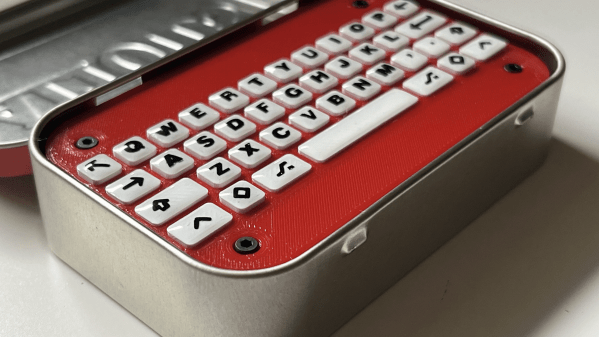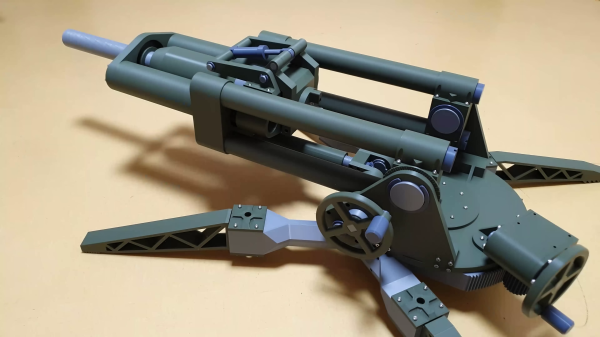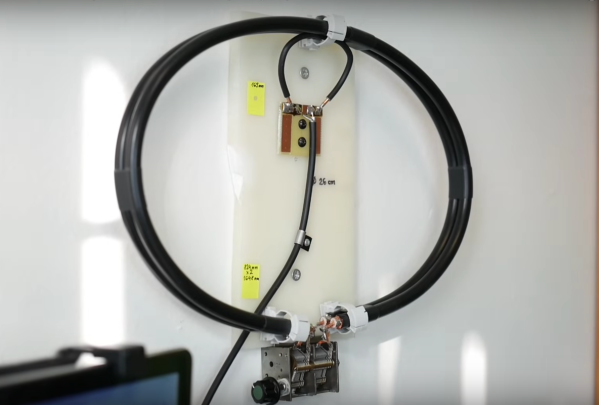Things may not have gone as planned last week for the flying cellphone on Mars, but just because Ingenuity‘s flying career is over doesn’t mean there’s no more work to do. NASA announced this week that it’s going to try a series of “wiggle” maneuvers on Ingenuity‘s rotors, in an attempt to get a better look at the damage to the blade tips and possibly get some clues as to what went wrong. The conjecture at the moment seems to be that a large area of relatively featureless terrain confused the navigation system, which uses down-facing cameras to track terrain features. If the navigation program couldn’t get a bead on exactly how far above the ground it was, it’s possible the copter came in too hard and caused the rotor tips to dig into the regolith. There seems to be some photographic suggestion of that, with what looks like divots in the ground about where you’d expect the rotor tips to dig in, and even scraps of material that look out of place and seem to be about the same color as the rotor blades. All this remains to be seen, of course, and we’re sure that NASA and JPL are poring over all available data to piece together what happened. As much as we hate to say goodbye to Ingenuity, we eagerly await the post-mortem.
Altoids Tin Keyboard Is A Breath Of Fresh Air
Well, here’s a fresh idea! [flurpyflurples] is back from hiatus with the Mintboard, a 40% that fits inside of an Altoids tin. Who could ask for more than a rugged little Bluetooth keyboard with a built-in cover that fits in your pocket?
This build started with meticulously measuring the tin to figure out what kind of switches could be used. At first, this was going to be a 60% keyboard, but after a lot of design decisions and switch comparisons, [flurpyflurples] settled on a certain micro switch spaced at 7.3mm for a 40% layout. Then it was time to design a PCB.
 Although [flurpyflurples] tends to use Arduino Pro Micros in their builds, they went with the Nice! Nano this time for the Bluetooth capabilities. This means that they had to program it with ZMK instead of QMK, but found that QMK knowledge transfers rather nicely.
Although [flurpyflurples] tends to use Arduino Pro Micros in their builds, they went with the Nice! Nano this time for the Bluetooth capabilities. This means that they had to program it with ZMK instead of QMK, but found that QMK knowledge transfers rather nicely.
Let’s talk about those lovely legends. The keycaps are 3D printed of course, and the legends were cut out on a Cricut machine. The best part is that sealant — [flurpyflurples] used a few drops of UV nail polish top coat and cured it with light.
We think this looks and sounds fantastic, and would really like to know how to get such clean cutouts. According to [flurpyflurples] and the end of the build/demo video you’ll find below the break, the action is a lot like a Blackberry keyboard.
Continue reading “Altoids Tin Keyboard Is A Breath Of Fresh Air”
Sega’s AI Computer Embraces The Artificial Intelligence Revolution
Recently a little-known Sega computer system called the Sega AI Computer was discovered for sale in Japan, including a lot of the accompanying software. Although this may not really raise eyebrows, what’s interesting is that this was Sega’s 1986 attempt to cash in on Artificial Intelligence (AI) hype, with a home computer that could handle natural language. Based on the available software and documentation, it looked to be mostly targeted at younger children, with plans to launch it in the US later on, but ultimately it was quietly shelved by the end of the 1980s.

The computer system itself is based around the NEC v20 8088-compatible MPU with 128 kB of RAM and a total of 512 kB of ROM, across multiple chips. The latter contains not only the character set, but also a speech table for the text to speech functionality and the Prolog-based operating system ROM. It is this Prolog-based environment which enables the ‘AI’ functionality. For example, the ‘diary’ application will ask the user a few questions about their day, and writes a grammatically correct diary entry for that day based on the responses.
On the system’s touch panel overlays can be used through cartridge or tape-based application to make it easy for children to interact with the system, or a full-sized keyboard can be used instead. All together, 14 tapes and 26 cartridges (‘my cards’) had their contents dumped, along with the contents of every single ROM in the system. The manual and any further documentation and advertising material that came with the system were scanned in, which you can peruse while you boot up your very own Sega AI Computer in MAME. Mind that the MAME system is still a work in progress, so bugs are to be expected. Even so, this is a rare glimpse at one of those aspirational systems that never made it out of the 1980s.
Popup Playground Roams Around
Going to the park is a time-honored pastime for kids around the world, but what if there isn’t one nearby? COMPA Teatro Trono and the International Design Clinic have designed a park that can come to you.
Working with a group of design students from Bolivia and America, the theatre troupe has iteratively designed a set of playground carts that can be deployed for kids to meet each other and play. El Alto, the city of 1 million where the playground plies the streets, has grown exponentially since its incorporation as an independent town in 1985. Infrastructure has trouble catching up with population jumps of 54% like that experienced from 2000-2010.
Starting with interviews with kids from the city about what was important for a playground, they found a trend of trees, slides, and the color green. Over the course of three summers, the design students went from janky prototypes to the more refined carts now seen roaming El Alto built around the idea of “exaggerated topography.” An elephant and “astroturf bee” are the two hand carts which disassemble into a variety of playground equipment once in place at a destination.
Not a ton of details are given in the article about the construction of the carts themselves, but we think this tactical urbanist approach to parks is a hack in itself. That said, be sure to point us toward some more info on the builds if you’ve found any. Know of another hack, that brings joy to your own neighborhoods? Send it to the tipsline!
POP! Goes The Hydrogen Howitzer
Military models are great 3D printing projects, even more so if they are somewhat functional. [Flasutie] took it a step further by engineering a 3D-printed howitzer that doesn’t just sit pretty—it launches shells with a hydrogen-powered bang.
This project’s secret sauce? Oxyhydrogen, aka HHO, the mix of hydrogen born when water endures the electric breakup of electrolysis. [Flasutie] wanted functional “high explosive” (HE) projectiles to pop without turning playtime into emergency room visit, and 30 mm was the magic size, allowing the thin-walled PLA projectile to rupture without causing injury, even when held in the hand. To set off the gaseous fireworks, [Flasutie] designed an impact fuze featuring piezoelectric spark mechanism nestled within a soft TPU tip for good impact sensitivity.
The howitzer itself is like something out of a miniaturized military fantasy—nearly entirely 3D printed. It boasts an interrupted thread breech-locking mechanism and recoil-absorbing mechanism inspired by the real thing. The breechblock isn’t just for show; it snaps open under spring power and ejects spent cartridges like hot brass.
Watch the video after the break for the build, satisfying loading sequence and of course cardboard-defeating “armor piercing” (AP) and HE shells knocking out targets.
Common Enzyme Breaks Down PLA Fast
The global issue of plastic waste has prompted scientists to seek innovative solutions for recycling. Single-use plastics, notorious for their environmental impact, require new methods for efficient and sustainable management. For some common plastics, though, salvation could be at hand, with researchers identifying a common enzyme that can be used to break them down fast.
Researchers at King’s College London have discovered an enzyme used in laundry detergents that can break down PLA plastics within 24 hours, using a little heat as an aid. Normally, this is achieved via composting methods that take weeks or months. This method transforms the plastics back into their original chemical components, offering a rapid and eco-friendly recycling process. The monomers can then be reused for manufacturing new plastic items.
One wonders if this could also be used in another way – perhaps in a multimaterial printer, allowing PLA to be used for supports and then broken down. It’s probably not that necessary, given other degradable materials exist, but it’s something to think about.
This project is a significant leap forward in recycling technology, showcasing the potential for enzymes to revolutionize how we handle plastic waste. It could also be a great way to recycle all those errant deformed Pikachus that keep ending up in your hackerspace’s 3D-printing waste basket. In any case, plastic waste is a problem the world needs to solve, and quickly, because it’s not going anywhere any time soon. Video after the break.
HF In Small Spaces
Generally, the biggest problem a new ham radio operator will come across when starting out on the high frequency (HF) bands is finding physical space for the antennas. For a quick example, a dipole antenna for the 20 m band will need around 10 m of wire, and the lower frequencies like 80 m need about four times as much linear space. But if you’re willing to trade a large space requirement for a high voltage hazard instead, a magnetic loop antenna might be just the ticket.
Loop antennas like these are typically used only for receiving, but in a pinch they can be used to transmit as well. To tune the antennas, which are much shorter than a standard vertical or dipole, a capacitor is soldered onto the ends, which electrically lengthens the antenna. [OM0ET] is using two loops of coax cable for the antenna, with each end soldered to one half of a dual variable capacitor which allows this antenna to tune from the 30 m bands to the 10 m bands, although he is using it mostly for WSPR on 20 m. His project also includes the use of an openWSPR module, meaning that he doesn’t have to dedicate an entire computer to run this mode.
The main downsides of antennas like these is that they are not omnidirectional, are not particularly good at transmitting, and develop a significantly high voltage across the capacitor as this similar mag loop antenna project demonstrated. But for those with extreme limitations on space or who, like [OM0ET] want a simple, small setup for running low-power applications like WSPR they can really excel. In fact, WSPR is a great mode for getting on the air at an absolute minimum of cost.


















